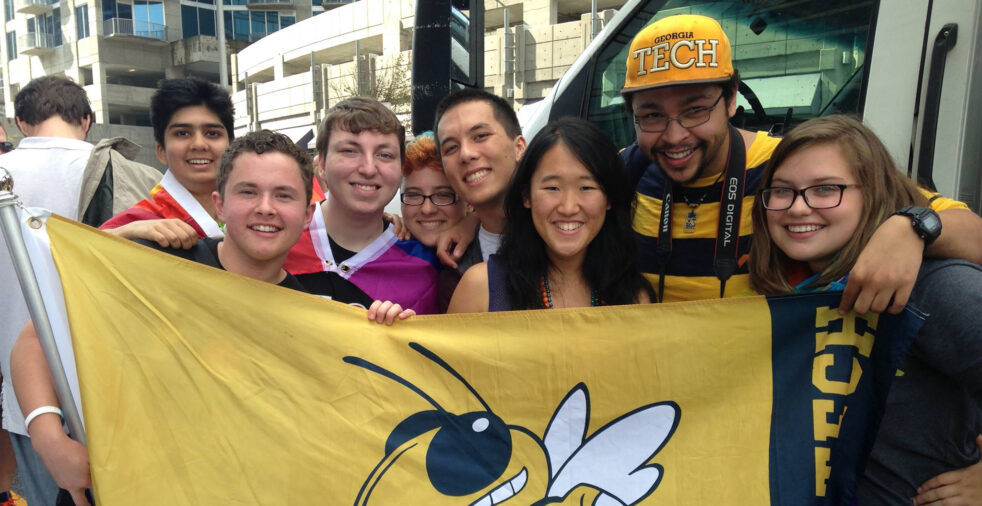In the last decade, the LGBTQ+ community has seen a rise in representation in the media, particularly of gay and lesbian characters. While many acknowledge this as generally beneficial, it is still crucial to recognize that these portrayals are frequently based on – often negative – stereotypes.
Additionally, other under-acknowledged gender and sexual identities, such as asexuality, pansexuality, and nonbinary, are still not represented on screen as often as their other LGBTQ+ counterparts. And above all, audiences can’t trust these depictions as representative of all identities and personal histories within the label.
So where can prospective allies turn to learn more about identities, terminology, and how best to support their LGBTQ+ peers?
Since 2001, Tech has hosted the Safe Space ally training program to further educate those who wish to engage with the LGBTQ+ community in a positive and ethical way.
“The goal of it is to educate and teach the rest of campus about the terminology to use, how to be an ally, better practices that you can employ if you’re a peer or a faculty and staff to create safer, more accessible environments for queer and trans folks,” Tegra Myanna, the director of Tech’s LGBTQIA Resource Center, said. “It’s an education program, so that as you’re a queer or trans student or faculty and staff member navigating campus, people are using your correct name more regularly and not making assumptions about who you are or who you may love.”
The program is open to all Tech employees, graduate students, and postdoctoral fellows; often, even those who identify as LGBTQ+ can still be knowledgeable about others who share the same label or identify under a different label.
For undergraduate students who are also interested in getting involved with practicing LGBTQ+ allyship, the Resource Center also offers a similar program, Safe Space: Peer Education, which is facilitated by and for students, so that students may feel more comfortable learning and asking questions.
The content that is covered is uniform for either program, so undergraduate students and employees are learning the same information.
“We go over terminology, so just explaining all the letters in LGBTQIA,” Camilla Brewer, coordinator of the LGBTQIA Resource Center, said. “We also go over steps to being an ally, and we use an academic model of how to build allyship. We also talk about some policies that affect LGBTQIA+ folks at Tech, do some myth busting there, [and] just make the campus more aware of inclusive policies on campus.”
Both Myanna and Brewer have gone through the Safe Space program at their respective undergraduate universities, but had exceedingly dissimilar experiences. Myanna attended the program as an ally, as they were unaware of their identity as LGBTQ+ in college.
“I grew up in rural Nebraska without a strong connection or community of LGBT folks,” they said. “For me, it just helped me be more knowledgeable about the community in general as someone who didn’t really know anything.”
Brewer, who has been openly LGBTQ+ for much longer and therefore did not attend as an ally, still had so much learning to do that she didn’t know she needed.
“I was not very knowledgeable about trans communities or trans issues, so when I attended, I was like, ‘Yes, I might have my personal experience, but then there’s so many other people that exist under this wonderful umbrella,’” she said. “It was still a point of learning. There were also trans folks in my fraternity, so [there was a question of] how I could be an ally to them.”
The intersectional nature of the program is crucial, as it highlights that gender and sexuality, despite sometimes both falling under LGBTQ+, are vastly different things. Further, the stories of two people under the same label are almost always two diverging experiences.
“For some people, [gender and sexuality] might be the same thing, like I can say that I’m queer, and that encompasses everything about my gender and sexuality, but I think for many folks, they’re separate but connected,” Myanna said. “You might be really understanding and knowledgeable about what it means to be gay and lesbian, but have no knowledge about what it means to be a trans woman who is also a lesbian. Those experiences are the same label-wise, like both women and both lesbians, but the experience to that label is so vastly different. I think the training helps to highlight that a little bit.”
The ultimate goal of Safe Space is to educate participants on the complex nature of gender and sexuality, the former often being confused with sex and gender expression.
